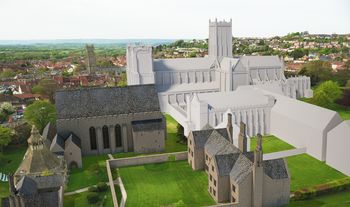Glastonbury Abbey: Archaeology, Legend and Public Engagement
Patrick Gibbs, Geoff Arnott, Anthony Masinton, 2018. https://doi.org/10.5284/1047222. How to cite using this DOI
Data copyright © University of York unless otherwise stated
This work is licensed under the ADS Terms of Use and Access.
Primary contact
Patrick
Gibbs
Centre for the Study of Christianity and Culture
BS/119 Berwick Saul Building
University of York
Heslington
York
YO10 5DD
UK
Resource identifiers
- ADS Collection: 3063
- DOI:https://doi.org/10.5284/1047222
- How to cite using this DOI
Introduction

This AHRC-funded Follow-On project was led by Professor Roberta Gilchrist of Reading University and was undertaken in partnership with the Centre for the Study of Christianity and Culture at the University of York. The original 3-year AHRC project, 'The Glastonbury Abbey Archaeological Archive Project (2009-2013), had undertaken a complete analysis of previously unpublished excavations at Glastonbury Abbey, with outputs aimed primarily at academic audiences.
This purpose of this Follow-On project was to make this research available in an accessible form to new audiences, including the 100,000+ visitors to Glastonbury Abbey, the local community and the wider public. The approach utilised digital media, including 3D visualisations of abbey buildings from different phases, and an interactive map of the site created using drone footage into which the digital modelling would be integrated. Included were visualisations of the earliest known buildings on the site, the 'vetusta ecclesia' or 'old church', plus the three phases of Anglo-Saxon development through to the buildings of the later medieval period.
The models enabled challenging evidence of various forms to be presented in an accessible, layered way, enabling public access to important themes such as the legends of King Arthur and Joseph of Arimathea and highlighting the importance of key spaces to the retelling and continuity of these myths. Target audiences for these outputs were younger visitors and school groups (KS1-3) as well as foreign language audiences for whom the visual elements would enhance engagement with the site. The media was presented on-site via touchscreens in the visitor centre and via tablets (obtainable from the visitor centre) that could be used when exploring the abbey site. Alongside this media, a website was created that presented much of the touchscreen content in a web-accessible form - http://www.glastonburyabbeyarchaeology.org.
The core aim was to tell the story of Glastonbury through the lens of archaeology and the findings of the original research project. The need was to address clearly-defined non-academic audiences by improving spatial orientation and chronological understanding. The project was to address issues of authenticity, by showing change over time and the role of archaeology in interpretation.






